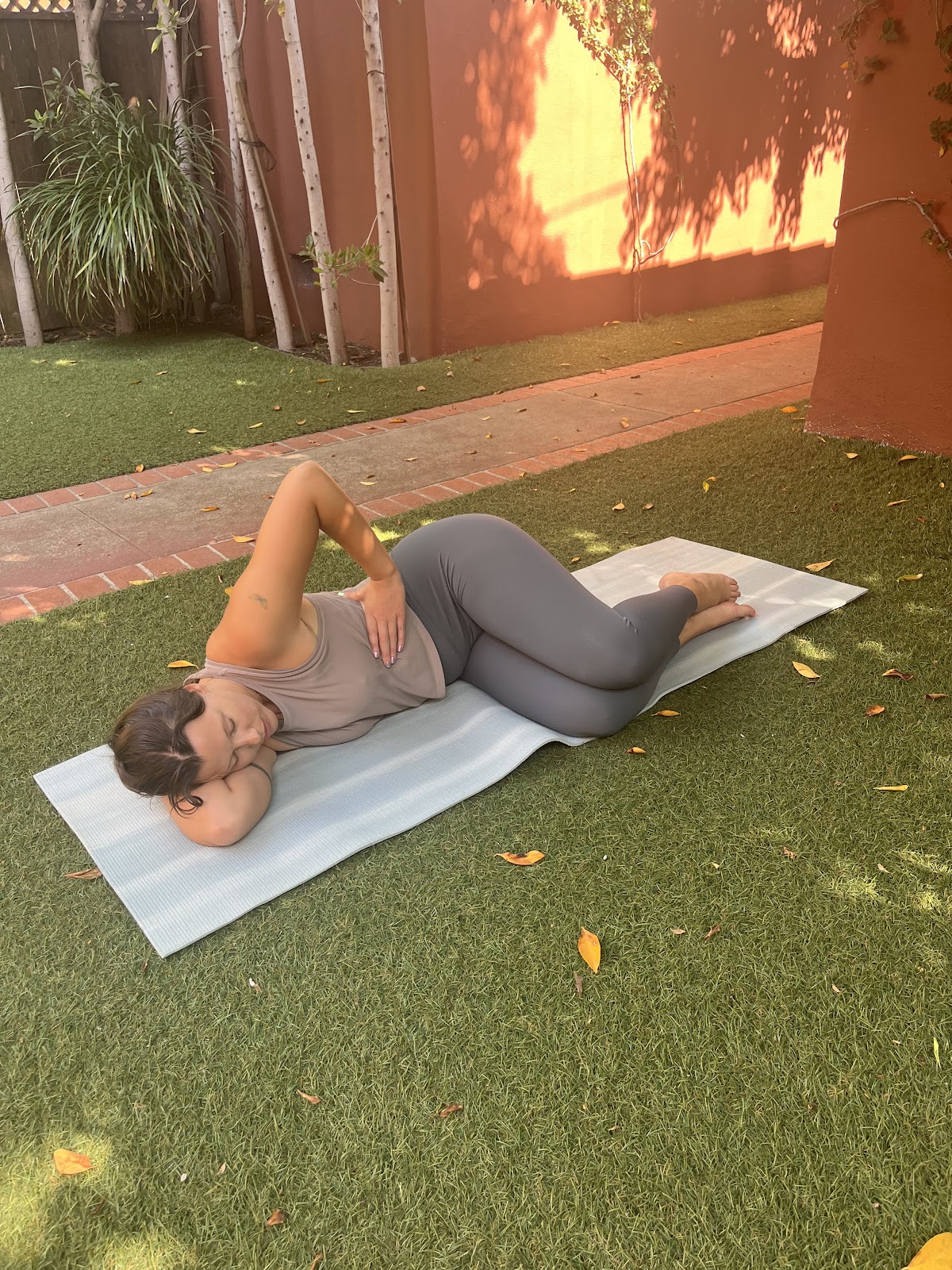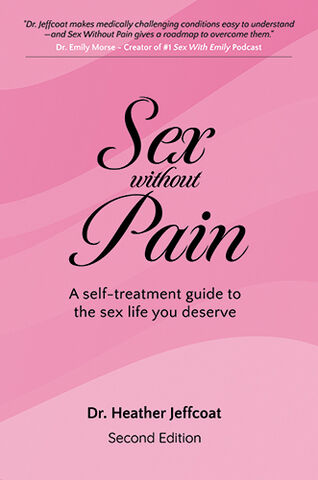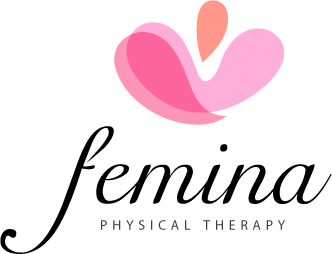
The Femina Physical Therapy Blog
Featuring original articles by our staff about current events and trends
Explore our insightful blog articles on pelvic health, where we delve into essential topics that empower and educate. From understanding pelvic floor disorders to strategies for conquering infertility, our content is designed for those seeking knowledge and support. We discuss the latest research, expert advice, and practical tips to enhance your well-being and foster a deeper connection to your body.
Featured From the Blog:
Understanding Relaxin: Why It Doesn’t Cause Pain in Pregnancy

Pregnancy is a time of significant physical and hormonal changes, and among the many hormones involved, Relaxin plays a crucial role. However, there’s a common misconception that Relaxin is responsible for pain during pregnancy. Let’s take a closer look at what Relaxin does and why it doesn’t directly cause pain.
What is Relaxin?
Relaxin is a regulatory hormone involved in growth, metabolism, and tissue remodeling after an injury to our bones, ligaments, muscles or tendons (Dehghan 2014). During pregnancy, Relaxin levels begin to increase in the first trimester to help the body prepare for childbirth by relaxing the ligaments in the pelvis and softening the cervix (Aldabe 2012, Daneau 2014). The ligaments of the pelvis will begin to relax around the 10th-12th week of pregnancy (Aldabe 2012). This process allows for greater flexibility in the pelvic area, facilitating delivery and accommodating the growing baby.
Read more: Understanding Relaxin: Why It Doesn’t Cause Pain in...
Therapeutic Breast Massage in Lactation (TBML)

Therapeutic Breast Massage in Lactation Can Help Make Breastfeeding Less Painful
Breastfeeding is widely accepted as the normal standard for providing nutrition to newborns, however, many women who do not reach their breastfeeding goals. US national data stated that breast pain was a commonly reported reason for women weaning less than 1 month postpartum. Within that segment, 29% of women who participated in the study stated that “breastfeeding was too painful” to continue.
In the same study, 24% of women reported “breasts feel(ing) too full or engorged” as another reason to discontinue breastfeeding prior to 1 month postpartum.1 Currently, The American Academy of Pediatrics recommends exclusive breastfeeding of infants for the first six months of life. As physical therapists who treat patients with postpartum conditions, we are well positioned to make a big impact on patients with breastfeeding related pain and reduce barriers to continued breastfeeding!
Restorative 20 Minute Home Yoga Practice For Chronic Pelvic Pain

Yoga Practice For Chronic Pelvic Pain Can Be a Very Helpful Routine
As stated in my last blog post, yoga can be so beneficial as a pain management tool due to its ability to modulate the sympathetic nervous system3,4 which plays a large role in chronic pain. The exact mechanism of how yoga helps with chronic pain is still being studied, however, it is reasonable to believe the full body relaxation promoted by a yoga practice helps to decrease tension in key muscle groups- including the hips and pelvic floor which are often tight in people with chronic pelvic pain.
Currently, evidence has mostly focused on one hour long practices as an intervention, although there are some studies that report improvements in pain with shorter practices, such as the routine below. As with any mobility/stretching routine, benefits will be seen with more frequent practice, however even twice weekly can help decrease pain.
Read more: Restorative 20 Minute Home Yoga Practice For Chronic...
- Details
- Written by: Debbie Dy, PT, DPT
- 352 Views

Anorectal symptoms such as hemorrhoids, anal fissures, and anal pain are common during pregnancy and the postpartum period and can have a negative impact on one’s quality of life. They can be one cause of uncomfortable pain in the butt and anal area, but read on—there is hope!
This article will go over:
- Statistics related to hemorrhoids, anal and rectal pain during pregnancy
- Contributing factors to hemorrhoids, anal and rectal pain
- Birth Prep to improve your delivery experience
- How pelvic floor physical therapy can help!
How Common Are Hemorrhoids During Pregnancy?
The incidence of symptomatic hemorrhoids during pregnancy varies between 24-38%, increasing to 85% in the last trimester. Hemorrhoids are also very prevalent in the first 3 months postpartum, with the prevalence increasing with age and parity (the number of times you’ve delivered).
How Did I Get Hemorrhoids?
Many factors contribute to the development of hemorrhoids, including various musculoskeletal, hormonal and circulatory changes that occur during pregnancy.
- Increased intra-abdominal pressure compresses the pelvic veins, the inferior vena cava, and results in venous dilation (swelling or widening of the veins)
- Increased progesterone levels also lead to venous dilation and swelling
- Increased tension at symphysis pubis caused by high progesterone levels
- Physiological changes in blood volume that increases by 25-50% during the third trimester
Constipation increases the risk of hemorrhoids during pregnancy and prevalence of constipation in pregnancy by 11 to 38%.
Sex hormones are a large factor contributing to high rates of constipation in pregnancy, especially in the first trimester.
- Rising levels of progesterone cause relaxation of smooth muscle which leads to decrease in bowel motility.
- This, combined with growth of the fetus prevents movement of feces through the bowel, making defecation mechanically difficult.
- Prolonged straining during defecation due to constipation leads to an increase in intra-abdominal pressure, contributing to hemorrhoids.
Other factors that contribute to the development of hemorrhoids:
- High body mass index (BMI)
- Iron supplementation
- Hypermobility associated with connective tissue disorders
- Low fiber and water intake
- Sedentary lifestyle
- Higher number of pregnancies
- Increased anxiety and/or depression (due to nervous system effects)
Previous prolonged delivery, higher birth weight of more than 8.5 pounds, traumatic second stage of labor all additionally contribute to increased risk of postnatal hemorrhoids and anal fissures.
The Role Of Pelvic Floor Physical Therapy (PFPT)
Pelvic floor physical therapy for hemorrhoids, anal fissures and rectal pain focuses on relaxation of tight (or hypertonic/overactive) muscles, education on proper bowel mechanics and strategies to improve bowel movements, nervous system downtraining exercises (include Vagus nerve activation), restoring postural alignments, strengthening weak muscles and rehabilitating other aspects of the pelvic floor muscles. The pelvic floor muscles support the uterus, bladder, and rectum and when dysfunctional, can lead to developing hemorrhoids, anal or rectal pain. Pelvic Floor Physical Therapy can be instrumental in managing and alleviating hemorrhoid and other symptoms during and after pregnancy.
Benefits of Pelvic Floor Physical Therapy for Hemorrhoids
- Improved Circulation: Pelvic floor exercises can enhance blood flow in the pelvic region, reducing swelling and discomfort associated with hemorrhoids.
- Strengthening Pelvic Muscles: A stronger pelvic floor can improve management of intra-abdominal pressure, potentially preventing the development or worsening of hemorrhoids.
- Enhanced Bowel Function: PFPT can address constipation by promoting better bowel habits and reducing straining during defecation.
Teaching Optimal Labor and Delivery Positions
An often-overlooked benefit of pelvic floor physical therapy is the education it provides regarding labor and delivery positions. Prolonged labor can increase the risk of hemorrhoids due to sustained pressure on the pelvic floor region. Our physical therapists can teach positions that:
- Reduce the risk of prolonged labor by promoting effective pushing strategies.
- Minimize strain on the pelvic floor muscles, thereby decreasing the likelihood of developing or worsening hemorrhoids during delivery.
- Encourage proper alignment and relaxation to facilitate a smoother birthing process.
- Reduce risk of perineal tearing
Conclusion
Hemorrhoids and anal and rectal pain are a prevalent issue during pregnancy and the postpartum period, influenced by factors such as age, multiple pregnancies, and constipation. Pelvic floor physical therapy offers a non-invasive, comprehensive approach to manage symptoms, prepare for labor, and protect pelvic health.
If you're pregnant or postpartum, consulting with a pelvic floor physical therapist can provide personalized strategies for symptom relief, improved bowel habits, and labor preparation, ultimately enhancing your comfort and quality of life. Contact us at Femina to get the pelvic health solutions you deserve!
References:
Gülören, Gülbala PT, PhD, Çınar, Gamze Nalan PT, MSc, et al. Hemorrhoids, Anorectal Symptoms, and Related Risk Factors in Pregnancy and the Postpartum Period: A Follow-up Study. Journal of Women’s & Pelvic Health Physical Therapy 48(3):p 184-193, July/September 2024. | DOI: 10.1097/JWH.0000000000000308
Longo SA, Moore RC, Canzoneri BJ, Robichaux A. Gastrointestinal conditions during pregnancy. Clin Colon Rectal Surg. 2010;23(2):80–89. doi:10. 1055/s-0030-1254294.
Bužinskiene D, Sabonyte-Balšaitienė Ž, Poškus T. Perianal diseases in pregnancy and after childbirth: frequency, risk factors, impact on women’s quality of life and treatment methods. Front Surg. 2022;9:788823. doi:10. 3389/fsurg.2022.788823
- Details
- Written by: Kasia Gondek, PT, DPT, CLT, CSCS
- 381 Views

It is not uncommon for patients with autoimmune diseases to come see us because of difficulties with arousal, pain with sex or orgasms, and/or erectile dysfunction. This is because the chronic inflammation that occurs with autoimmune conditions impacts how nerves function, alters blood flow, and can make it difficult to sustain an erection or can cause vaginal dryness.
Additionally, joint pain, muscle aches, and other pain symptoms associated with autoimmune diseases can make sexual activity uncomfortable or painful, and some autoimmune conditions can disrupt hormone balance, impacting sexual desire, arousal and overall sexual function. Autoimmune conditions like lupus, Sjogren’s syndrome, type 1 diabetes and rheumatoid arthritis are examples of systemic autoimmune diseases that can be associated with sexual dysfunction.
Are Autoimmune Conditions Linked to Sexual Dysfunction?: What the Research Says
One meta analysis and systematic review conducted by Minopoulou I, Pyrgidis N, Tishukov M, et al. in 2023 found that 63% of people with a systemic autoimmune rheumatic diseases (like lupus, Sjogren’s, and rheumatoid arthritis) have sexual dysfunction. They found that women with Sjögren's syndrome and systemic sclerosis reported the highest levels of sexual dysfunction.1
Additionally, “A 2024 meta-synthesis of 6 studies involving people with inflammatory arthritis conditions found that sexual function was impacted by pain, lower sexual desire, erectile dysfunction, fatigue, fluctuations in disease activity, altered self-image, and confidence in sexuality, with negative impacts on intimate relationships with partners.”2,3
What Can Pelvic Floor Therapy Do to Help My Autoimmune Condition?
If you have been diagnosed with an autoimmune disease and notice that you have any symptoms of sexual dysfunction, our pelvic health physical therapists can help you! When a person comes to us with sexual dysfunction and also has an autoimmune condition, we take a thorough history of their symptoms, previous treatments, current medications, and current providers. We then conduct an orthopedic assessment that includes screening the spine, hips, legs and feet, as well as any other body regions that may be impacted by the person’s condition.
This may include observation of day-to-day movements such as bending over, reaching, squatting, walking, and balance. Additionally, we check the range of motion and flexibility, muscle and soft tissue mobility and tender points, strength and muscle coordination. This is followed by a pelvic floor assessment, which entails observation of pelvic floor muscle function and tissue health and checking for any trigger points/tenderness in the person’s pelvic floor muscles externally and internally, depending upon the person’s comfort level at that time. The goal of these assessments is to determine what is driving the person’s sexual dysfunction and pain and then target physical therapy treatment toward these areas.
How Long Until I See Results in Physical Therapy?
Each person’s physical therapy treatment plan is unique because no two people are exactly alike! In general, people will begin to see improvements in their pain and functioning in about four sessions, however the complete treatment plan duration does vary from person to person depending upon their symptoms, areas of treatment, and how long symptoms have been going on.
Our Pelvic Health Physical Therapists Are Here to Support You!
All of our physical therapists at Femina have specialized training in treating and healing pelvic pain, sexual dysfunctions, and the associated difficulties with day-to-day functioning that can go along with an autoimmune disease. Our goal is to provide compassionate, evidence-based, and effective treatments to help you feel and function at your best. If you need pelvic floor physical therapy in Los Angeles, contact our office to start getting the care and support you deserve.
Sources:
- Minopoulou I, Pyrgidis N, Tishukov M, et al. Sexual dysfunction in women with systemic autoimmune rheumatic disorders: a systematic review and meta-analysis. Rheumatology (Oxford). 2023;62(3):1021-1030. doi:10.1093/rheumatology/keac457
- Ackerman IN, Restoux L, Dobo B, Slater H, Ross MH, Briggs AM. Holistic Care for People Living With Chronic Musculoskeletal Pain: The Relevance and Importance of Sexual Function. Phys Ther. 2024;104(8):pzae083. doi:10.1093/ptj/pzae083
- Restoux LJ, Dasariraju SR, Ackerman IN, Van Doornum S, Romero L, Briggs AM. Systematic review of the impact of inflammatory arthritis on intimate relationships and sexual function. Arthritis Care Res. 2020;72:41–62. doi: 10.1002/acr.23857.
- Details
- Written by: Debbie Dy, PT, DPT
- 444 Views

Recurrent urinary tract infections (UTIs) are a common issue that we have seen more and more in our practice in recent years, particularly among women. You’ll seldom find a woman who hasn’t had at least 1 UTI in their lifetime, however, recurrent UTIs can significantly impact quality of life. Antibiotics are often first-line treatments for acute UTIs. However, this can be problematic for those dealing with recurrent UTIs due to the frequent disruption of the gut microbiome, as well as the increasing risk of contracting antibiotic-resistant UTI bacteria with repeated use.
The American Urological Association defines recurrent UTIs as “two separate culture-proven episodes of acute bacterial cystitis and associated symptoms within 6 months or 3 episodes within 1 year.”
Emerging evidence suggests that pelvic floor dysfunction may contribute to these recurrent infections. Addressing this dysfunction through physical therapy offers a promising alternative for reducing UTI frequency without antibiotic use, and for alleviating associated symptoms.
This article reviews information about Urinary Tract Infections (UTIs), understanding the link between UTIs and pelvic floor dysfunction, as well as how pelvic floor therapy can help. Recurrent urinary tract infections (UTIs) are common, especially among women, and can significantly impact quality of life. Emerging research suggests that pelvic floor dysfunction and hormonal changes, particularly during menopause, may contribute to recurrent UTIs, making physical therapy an effective alternative to frequent antibiotic use. By improving pelvic floor muscle coordination and addressing voiding dysfunction, physical therapy can help reduce UTI frequency and enhance overall urinary health.
Understanding the Link Between Pelvic Floor Dysfunction and UTIs
The pelvic floor muscles play a crucial role in urinary function. Dysfunction in these muscles can lead to issues such as urinary incontinence (UI) and voiding dysfunction, which may increase the risk of UTIs. For instance, non-relaxing pelvic floor muscles can disrupt the normal flow of urine (think like kinking a garden hose), allowing bacteria in retained urine to remain in the urinary tract and potentially cause infections.
Recurrent UTIs and Menopause
The hormonal changes associated with menopause, particularly the decline in estrogen levels, can significantly affect the genitourinary system. This condition, known as genitourinary syndrome of menopause (GSM), encompasses a range of symptoms, including:
- Vaginal dryness and atrophy
- Increased urinary frequency and urgency
- Dyspareunia (pain during intercourse)
- And notably, recurrent UTIs
Estrogen plays a vital role in maintaining the health of the urogenital tissues. Its decline during menopause can weaken the epithelial lining of the bladder and urethra, impair the pelvic floor muscles, and disrupt the vaginal microbiota, all of which may increase susceptibility to UTIs.
A study published in the Journal of Menopausal Medicine emphasizes that addressing GSM through hormonal therapies and physical therapy interventions can significantly alleviate these symptoms and reduce the risk of recurrent infections.
How Can Physical Therapy Help in Managing Recurrent UTIs?
Physical therapy aims to improve pelvic floor muscle function, which can:
- Enhance muscle coordination: Proper coordination of pelvic floor muscles ensures complete bladder emptying, reducing residual urine where bacteria can thrive.
- Address voiding dysfunction: Therapies targeting voiding dysfunction can prevent involuntary contractions of the external urethral sphincter during urination, promoting a healthier urinary flow.
- Reduce dependence on antibiotics: By addressing the root cause of recurrent UTIs, physical therapy may decrease the need for antibiotics, mitigating the risk of antibiotic resistance.
Physical therapists can provide treatment such as:
- Perform manual therapy on overactive pelvic floor muscles to improve voiding dysfunction and coordination
- Education on proper bladder habits and hygiene to reduce UTI frequency
- Provide referrals to menopause specialists to help sort out any hormonal dysfunction that may be leading to decreased health of urogenital tissues
Get Pelvic Health Physical Therapy
Recurrent urinary tract infections (UTIs) are a common issue, particularly among women, and can significantly impact quality of life. Traditional treatments often focus on antibiotics; however, emerging evidence suggests that pelvic floor dysfunction and other factors, such as hormonal changes during menopause, may contribute to these recurrent infections. Addressing these underlying issues through physical therapy offers a promising alternative for reducing UTI frequency and alleviating associated symptoms.
Incorporating physical therapy into the treatment plan for individuals experiencing recurrent UTIs offers a conservative and effective approach to addressing underlying pelvic floor dysfunction. By enhancing muscle coordination and addressing voiding dysfunction, physical therapy can reduce the frequency of UTIs and improve overall urinary health. Individuals suffering from recurrent UTIs should consider consulting a pelvic health physical therapist to explore this treatment option. Suffering from chronic UTIs? Our highly trained staff of physical therapists at Femina are here for you!
References:
- Divine, Kate PT, DPT, WCS; McVey, Lisa PT, DPT. Physical Therapy Management in Recurrent Urinary Tract Infections: A Case Report. Journal of Women's Health Physical Therapy 45(1):p 27-33, January/March 2021. | DOI: 10.1097/JWH.0000000000000189
- Kim, H. K., Kang, S. Y., Chung, Y. J., Kim, J. H., & Kim, M. R. (2015). The Recent Review of the Genitourinary Syndrome of Menopause. Journal of menopausal medicine, 21(2), 65–71. doi:10.6118/jmm.2015.21.2.65
- Mareș C, Petca RC, Popescu RI, Petca A, Mulțescu R, Bulai CA, Ene CV, Geavlete PA, Geavlete BF, Jinga V. Update on Urinary Tract Infection Antibiotic Resistance-A Retrospective Study in Females in Conjunction with Clinical Data. Life (Basel). 2024 Jan 9;14(1):106. doi: 10.3390/life14010106. PMID: 38255721; PMCID: PMC10820678.
- Details
- Written by: Ken Sinervo, MD, MSc, FRCSC, ACGE
- 578 Views

Disclaimer: The decision to undergo surgery for endometriosis is a personal one, and outcomes can vary. There are no universal guarantees, and each patient’s experience is unique. It is essential to discuss all treatment options with a qualified healthcare provider. The information provided herein is for educational purposes only and does not constitute medical advice or establish a doctor-patient relationship.
Excision Surgery For Endometriosis: Post-operative Pain Expectations
Guest Post Author: Ken Sinervo, MD, MSc, FRCSC, ACGE
Endometriosis is a systemic, inflammatory disease affecting an estimated 200 million girls and women (Yi et al., 2021) and unmeasured amounts of gender-diverse individuals globally. Characterized by the presence of endometrium-like tissue found in other areas of the body (Taylor et al., 2021), the disease has been documented in virtually every organ system and commonly presents with a variety of subtypes and clinical manifestations. Endometriosis can lead to significant decline in the quality of life of those affected and carries a heavy financial burden on society. For many, surgical intervention is a pivotal step toward both diagnostic confirmation and alleviating symptoms, particularly Laparoscopic Excision (LAPEX). LAPEX is considered by many to be the ‘surgical gold standard’ of operative treatment. Understanding expectations following LAPEX is vital for managing recovery and setting realistic post-operative goals.
Understanding Laparoscopic Excision
Surgical excision of endometriosis is a meticulous technique that aims not only to alleviate pain but also restore normal anatomical structures and functioning. Utilizing cutting techniques, the excisional method allows for thorough removal of lesions ‘root to tip’ and the subsequent pathological examination to confirm a diagnosis. In our Center, we utilize the laser as a cutting tool to resect and remove the disease from all involved areas, preserving healthy tissue and surrounding structures. This precise approach minimizes damage to adjacent areas, promotes faster healing, and enhances overall outcomes for our patients. Studies have demonstrated that excision is more effective than placebo in reducing pain and improving quality of life in all stages of disease, and is generally preferred for its superior outcomes (Rathod et al., 2024). Others have demonstrated that excision is also perceived as superior to ablation* in most measures (Isaac et al., 2024).
In general, Minimally Invasive Gynecologic Surgery (MIGS) like Laparoscopy involves smaller incisions and may result in less postoperative pain, shorter recovery times, and reduced scarring compared to traditional open surgery. Though MIG surgery is considered ‘minimally invasive,’ it can be quite technically complex and vary significantly in terms of techniques, extent of disease treated, and individual patient circumstances. Pain and recovery expectations following excision surgery subsequently vary significantly among individuals and are influenced by numerous factors. Surgical technique, patient characteristics, pain management strategies, and other dynamics all play a role, and educating patients preoperatively can help healthcare providers set realistic expectations, enhance education, and improve overall satisfaction with outcomes.
To that end, excision of endometriosis can be challenging due to several factors, not limited to:
- Extent of Disease: Endometriosis necessitates careful planning and skilled surgical techniques, often undertaken in an interdisciplinary operative setting with a team from gynecology, colorectal, and other specialties.
- Surgical Precision: The complex nature of the disease means the surgeon(s) must be highly skilled in cutting out the lesion(s) from wherever they are present while simultaneously preserving healthy tissue and adjacent organs. This requires an extremely high level of expertise which can only be gleaned through advanced training and high volume experience.
- Potential Complications: Even ‘minimally invasive’ procedures carry risks, including but not limited to bleeding, infection, and damage to surrounding organs. Patients must be fully informed about the benefits and drawbacks of any surgery, all possible risks, expected outcomes, and potential complications. The surgeon must be fully prepared to address unexpected events during surgery, including those involving the bowel, bladder, or nerves, and ensure that any such occurrences can be managed safely, swiftly, and effectively.
- Individual Variability: Each patient's experience with endometriosis and their response to surgery will differ based on personal and specific factors including disease severity, overall health, previous treatments, and more.
It is essential to recognize the complexities involved in excision surgery and the importance of a truly skilled surgical approach to achieve the best, safest outcomes for patients.
Overview of the Post-Operative Recovery Process
The post-operative phase is a crucial one, and understanding expectations and management, especially of pain, is essential for successful recovery. The process varies depending on the type of surgery, the individual’s general health and underlying conditions, and various other factors which could complicate or lengthen healing. A comprehensive approach to recovery includes effectively managing pain, preventing complications, promoting mobility, and supporting overall well-being.
While recovery is generally quicker versus open surgery, patients will still experience pain and discomfort. The healing process is not linear, and post-operative pain may ebb and flow throughout the days and weeks following surgery. The recovery process involves several stages:
Immediate Post-Surgery Phase (First 24-72 Hours)
- Hospital Monitoring: Vital signs, pain levels, and any immediate complications (such as bleeding or infection) are closely monitored.
- Mobility: Early movement, such as leg exercises or short walks, helps prevent blood clots and enhances circulation.
- Diet & Hydration: Patients may start with clear liquids before progressing to solid foods as tolerated.
- Pain Management & Realistic Understanding of Pain Expectations: This is crucial for patients undergoing any surgical procedure. It helps patients have a better sense on the level and duration of pain they may experience post-operatively. This knowledge can reduce anxiety and fear, and allows patients to mentally prepare for their recovery journey. Additionally, when patients are well-informed, they are more likely to communicate effectively about their pain levels, which is essential for timely intervention and support.
Post-operative pain can vary significantly among individuals and may include:
- Incisional Pain: This is localized pain at the site of surgery, typically managed with analgesics.
- Referred Pain: Pain that may occur in areas distant from the surgical site due to nerve pathways.
Pain is typically measured using the Numeric Rating Scale, where patients rate their pain from 0 (no pain) to 10 (worst pain imaginable). However, this can vary based on the type of surgery and individual pain thresholds.
- Immediate Post-Op (0-24 hours): Patients generally experience the highest levels of pain immediately after surgery.
- 24-72 Hours Post-Op: Pain levels typically peak within this timeframe, followed by a gradual decrease.
- Week 1-2 Post-Op: By the end of the first week, many patients report a reduced pain score, indicating transition from acute to more manageable pain.
- Week Two-Four: Most patients experience marked reduction in pain.
- Total healing can take 90 days or longer even after a patient has resumed normal activity levels, and patients may find that they experience painful periods for the first three cycles and/or have fatigue, transient pain, and other post-operatuve effects due to ongoing physical recovery, emotional stress, medication effects, overexertion, or sleep disturbances. It's important to listen to your body and consult your healthcare providers if symptoms seem disproportionate or persistent.
Effective pain management is a critical component of the recovery process, enabling patients to engage in rehabilitation activities and improve their quality of life post-surgery. Prioritizing pain control not only enhances recovery but promotes overall patient satisfaction. Depending on the case, this may involve opioid and/or non-opioid pain relievers, nerve blocks, anti-inflammatory medications and others. Pain levels can be influenced by various factors, including:
- Type of Procedure(s) Performed: The nature of procedures can significantly impact pain levels. More invasive surgeries, i.e., Video Assisted Thoracic surgery for lung endometriosis or bowel resection for invasive GI lesions may result in lengthier and higher pain levels compared to other LAPEX cases that do not involve such procedures.
- Individual Patient Factors: A patient’s pre-existing health and individual pain thresholds cannot be undervalued for their influence on how the patient experiences pain. Younger patients may recover faster, while older patients or those with chronic conditions may face additional challenges.
- Quality of Post-Operative Care & Monitoring: Effective post-operative care, including close monitoring and timely interventions, can significantly influence pain management outcomes and overall recovery. Patients should be educated on recognizing signs that indicate their pain may be excessive or not aligning with expected levels, such as increased intensity or changes in the character of pain. Clear guidelines should be provided to patients on when to reach out to healthcare professionals, including signs of complications or inadequate pain control.
Short-Term Recovery (First Few Weeks)
- Wound Care: Keeping the surgical site clean and dry reduces infection risk. Some patients may require drains, which must be managed properly.
- Activity Restrictions: Heavy lifting, strenuous activities, and excessive bending or stretching are discouraged. Frequent short breaks are encouraged.
- Non-Pharmacological Approaches (Ice, Elevation): Complementary methods like applying ice/heat or using relaxation techniques can help alleviate pain and swelling. Ongoing assessment of pain levels allows for adjustments in pain management strategies, ensuring that patients receive the most effective care tailored to their needs.
- Monitoring Bowel & Bladder Function: Post-op constipation is common, especially with opioid use. Increased fiber intake, hydration, and gentle laxatives may help. Voiding concerns should be addressed with the surgeon at the post-operative visit, if not before as necessary.
Mid-Term Recovery (Weeks to Months)
- Physical Therapy & Rehabilitation: Physical therapy plays a vital role in post-operative recovery, aiding in mobility, strength building, and pain reduction, ultimately facilitating a faster return to normal activities. Structured exercises with endometriosis- and pelvic pain-specialized PTs can be very helpful postoperatively to regain strength and flexibility and address secondary pain generators like pelvic floor dysfunction or others.
- Hormonal & Systemic Adjustments: For surgeries that involve post-operative medical therapy, hormonal changes may impact recovery.
Long-Term Recovery & Functional Restoration
- Emotional & Psychological Support: Depression and anxiety may arise post-surgery, particularly if chronic pain has been a longstanding issue. Support groups, therapy, and mindfulness practices can be helpful.
- Gradual Return to Normal Activities: Patients should pace themselves and listen to their bodies when resuming work, exercise, sex, and other routines.
- Always an important consideration, a balanced diet rich in protein, vitamins, and minerals is essential for postoperative healing, as it supports tissue repair, boosts the immune system, and promotes overall recovery.
- Follow-Up Appointments: Ongoing monitoring ensures healing is on track and complications are addressed.
Having a clear understanding of what to expect can lead to better adherence to pain management strategies, improve overall satisfaction with the surgical experience, and enhance cooperation between patients and their healthcare providers. Remember each patient’s recovery journey is unique, and a personalized plan - often involving a multidisciplinary approach - is essential for optimal outcomes.
Continued Post-Excision Pain: Is Something Wrong?
For many with endometriosis, LAPEX can provide significant relief. Some patients, however, can continue to experience pain long after the standard window of postoperative recovery. It is important to understand that excision is not a universal cure for endometriosis and that even removing all disease may not solve underlying issues for some individuals. It is also true that not all pain is from endometriosis. Persistent pain can stem from secondary pain generators and other factors such as surgical complications or underlying conditions that were not addressed during the procedure. Identifying the root cause for continuing symptoms is essential for effective management.
One major contributor to ongoing pain is secondary pain generators, which develop as a result of prolonged nerve sensitization, musculoskeletal dysfunction, or associated conditions. Central sensitization - where the nervous system remains in a heightened state of pain response even after the initial source is removed - can make post-surgical pain feel disproportionate. Pelvic floor dysfunction is also common, as chronic pain and inflammation from endometriosis can lead to muscle hypertonicity (tightness), which contributes to deep, aching pain, painful intercourse, and bladder or bowel dysfunction. In some cases, pain originates from nearby organs, such as the bladder (Bladder Pain Syndrome) or intestines (Irritable Bowel Syndrome), which can mimic endometriosis symptoms. Surgical complications may also play a role in continued pain.
Adhesions, or bands of scar tissue that form between organs and tissues, can cause pain by restricting movement and function. While meticulous surgical techniques and barriers can minimize formation, adhesions can still develop and lead to pain or issues.
Nerve-related pain is another potential cause, particularly if surgical dissection involved areas near the pudendal, ilioinguinal, or genitofemoral nerves. Neuropathic pain - described as burning, shooting, or tingling – may result from nerve irritation or injury.
In cases where incomplete excision occurs, residual endometriosis can continue to provoke inflammation and pain, particularly if deep infiltrating lesions remain in areas like the diaphragm or bowel.
Pain persistence may also be related to underlying autoimmune or inflammatory conditions that can exacerbate pain by amplifying the body's response to perceived threats.
A comprehensive post-surgical plan that includes Pelvic Physical Therapy, pain management, hormonal modulation if necessary, and/or lifestyle interventions including adequate nutrition is often appropriate to optimize recovery and reduce discomfort. Communication with your healthcare team is key. Patients should feel empowered to speak openly with their healthcare teams about their pain levels and any ongoing symptoms or concerns, fostering a truly patient- centered, collaborative approach to ongoing care and management.
In Conclusion
Understanding what to expect throughout the recovery process empowers patients, allowing them to navigate their journeys with greater confidence and a clearer perspective on their path to relief. Through thorough pre-operative education, effective pain and post-operative management strategies, and multidisciplinary, personalized care, healthcare providers can significantly improve outcomes in care. As we continue to explore the complexities of endometriosis management, it remains essential to support our patients in their recovery by providing them with the tools and knowledge necessary to enhance their quality of life, both immediately after surgery and for the long term.
Learn more from Dr. Sinervo and his team at The Center for Endometriosis Care
_______________________________________
Taylor HS, Kotlyar AM, Flores VA. Endometriosis is a chronic systemic disease: clinical challenges and novel innovations. Lancet. 2021;397(10276):839-852.
Yi M, Wang S, Zhang X, et al. Linc-ROR Promotes EMT by Targeting miR-204-5p/SMAD4 in Endometriosis. Reprod Sci. 2023;30(9):2665-2679.
Rathod S, Shanoo A, Acharya N. Endometriosis: A Comprehensive Exploration of Inflammatory Mechanisms and Fertility Implications. Cureus. 2024;16(8):e66128.
Isaac A, Kapetanakis T, Thibeault E, Chatburn L, Mackenzie M. Patient Perception and Experience of Laparoscopic Excision versus Ablation of Endometriosis: A Crowd-Sourced Comparative Evaluation of Symptom and Quality of Life Outcomes. J Minim Invasive Gynecol. Published online October 26, 2024. doi:10.1016/j.jmig.2024.10.014.
*The terms "ablation of endometriosis" and "endometrial ablation" sound similar but refer to completely different procedures with distinct purposes. Ablation of endometriosis is a surgical procedure often performed by those who are not trained in excision, as it requires less specialized skill and experience. The procedure burns or cauterizes lesions, but leaves deeper disease behind, leading to persistent endometriosis and ongoing symptoms. Endometrial ablation is a surgical procedure undertaken to destroy the uterine lining to reduce heavy menstrual bleeding. It is not among the accepted treatments for endometriosis, and the procedures serve different purposes.
- Details
- Written by: Debbie Dy, PT, DPT
- 206 Views

Lichen Sclerosus: What You Need to Know About This Common Yet Overlooked Vulvar Condition
Have you heard of Lichen Sclerosus (LS)?
It’s a chronic skin condition that affects the genital and anal areas, though it can appear elsewhere on the body. While LS can affect anyone, it’s most common in women after menopause. However, it may also occur in men and children, though less frequently.
At FeminaPT, we’re passionate about raising awareness around vulvar health conditions like LS—and how pelvic floor physical therapy can play an essential role in your healing journey.
What Does Lichen Sclerosus Look Like?
Lichen sclerosus typically presents as:
Thin, white, shiny, or wrinkled patches of skin
Areas that may feel itchy, sore, or painful
Fragile skin that tears or bruises easily
In more advanced cases, LS may cause:
Scarring
Labial fusion (where the labia stick together)
Clitoral adhesions (clitoral phimosis)
Vaginal atrophy (thinning of vaginal tissues)
These changes can significantly affect sexual health, urination, and daily comfort.
What Causes Lichen Sclerosus?
The exact cause of LS isn’t fully understood, but research suggests several contributing factors:
Hormonal changes, especially post-menopause
Autoimmune responses, where the immune system mistakenly attacks healthy skin
Genetics—it sometimes runs in families
Oxidative stress, which involves damage from unstable molecules in the body
Many people with LS also have other autoimmune conditions, such as thyroid disease or vitiligo.
How Is LS Diagnosed?
A healthcare provider can often diagnose LS by examining the affected skin. However, if there’s any uncertainty or concern for vulvar cancer (which LS slightly increases the risk for), a biopsy may be performed.
Treatment Options for Lichen Sclerosus
The primary goals of LS treatment are to:
Relieve symptoms
Prevent progression
Reduce cancer risk
Common treatments include:
1. Topical Steroid Creams:
The gold standard for LS treatment, potent corticosteroid creams reduce inflammation and promote healing.
2. Immune-Modulating Creams:
If steroids aren’t effective, medications like tacrolimus or pimecrolimus may be used to calm immune responses.
3. Hormone Therapy:
Hormonal deficiency often coexists with LS, especially after menopause. In some cases, topical estrogen may be prescribed to improve vulvar tissue health and reduce dryness or itching alongside other treatments.
Important: Early treatment is key to preventing permanent scarring or functional impairments.
Why Pelvic Floor Physical Therapy Matters for LS
While medical treatments focus on inflammation and skin health, pelvic floor physical therapy can play a crucial role in improving comfort, function, and quality of life for people living with LS.
At FeminaPT, our pelvic health physical therapists are specially trained to address:
Pain with intimacy (dyspareunia)
Clitoral phimosis (adhesion and restriction of the clitoral hood)
Pelvic floor muscle tension or dysfunction
How Does It Work?
We use gentle, evidence-based techniques such as:
Myofascial release
Soft tissue mobilization
Clitoral hood mobilization (to gently address adhesions and improve tissue mobility)
Breathwork and nervous system regulation to reduce protective muscle guarding
These hands-on therapies help to:
Improve circulation and tissue flexibility
Reduce pain
Restore normal movement and comfort during daily activities and sexual function
Supporting Research:
A 2015 study published in The Journal of Women's Health Physical Therapy showed that specific myofascial release techniques led to significant improvement in clitoral phimosis and painful intercourse among patients with LS.²
Additionally, a 2024 review in the Journal of Personalized Medicine emphasized the need for a multidisciplinary approach—including physical therapy—for optimal vulvar health outcomes.³
Why Stress & Emotional Support Also Matter
Living with LS can be physically and emotionally challenging. Stress may worsen symptoms or lead to protective pelvic muscle tension. Our holistic care approach includes:
Stress-reduction techniques
Breathing exercises
Education about pelvic health
Support for body confidence and sexual well-being
The Femina PT Takeaway
Lichen sclerosus doesn’t just affect the skin—it can impact daily function, sexual health, and overall well-being. However, with the right medical treatment and pelvic floor physical therapy, many people experience significant relief.
If you notice:
Persistent itching
White or wrinkled patches of skin
Pain with intimacy or urination
Don’t wait. Seek care from your healthcare provider and ask about integrating pelvic floor therapy into your treatment plan.
Our team at FeminaPT is here to support you through every step of your healing journey.
References
De Luca DA, et al. Lichen sclerosus: The 2023 update. Front Med (Lausanne). 2023;10:1106318.
Morrison P, et al. The Use of Specific Myofascial Release Techniques by a Physical Therapist to Treat Clitoral Phimosis and Dyspareunia. J Women's Health Phys Ther. 2015;39(1):17-28.
Popa A, et al. Vulvar Lichen Sclerosus: Navigating Sex Hormone Dynamics and Pioneering Personalized Treatment Paradigm. J Pers Med. 2024;14(1):76.
- Details
- Written by: Debbie Dy, PT, DPT
- 142 Views

At Femina Physical Therapy, we take a holistic approach to pelvic health. A healthy vaginal microbiome is essential not only for reproductive wellness but also for pelvic floor function, immunity, and overall well-being. Increasing research shows that disruptions to the vaginal microbiome—due to stress, hygiene habits, or recurrent infections like bacterial vaginosis (BV) and mycoplasma—can worsen pelvic floor dysfunction.
In this blog post, we’ll explore how pelvic floor therapy can support microbiome balance, improve vaginal health, and help you manage conditions like BV and mycoplasma.
The Vaginal Microbiome: A Cornerstone of Vaginal & Pelvic Health
The vaginal microbiome is a complex, dynamic ecosystem crucial to women’s health. A balanced microbiome protects against infections, supports fertility, and maintains optimal pH levels.
✅ The Role of Lactobacilli
Beneficial Lactobacilli bacteria dominate a healthy vaginal microbiome. They produce lactic acid to keep vaginal pH between 3.5 and 4.5, creating an acidic environment that prevents the growth of harmful microbes. Lactobacilli also produce protective compounds like hydrogen peroxide and bacteriocins that guard against infections.
However, when Lactobacilli levels drop, harmful bacteria such as Gardnerella, E. coli, and Mycoplasma can overgrow—leading to conditions like bacterial vaginosis (BV) and increased risk of other infections.
Psychosocial Stress: A Hidden Factor in Vaginal Microbiome Imbalance
Stress impacts far more than your mood—it also alters your vaginal microbiome.
🔸 How Stress Disrupts Vaginal Health:
- Chronic stress elevates cortisol, which can weaken immunity.
- High cortisol reduces protective Lactobacilli populations.
- This increases susceptibility to infections, including BV and mycoplasma.
By managing stress through mindfulness, exercise, and pelvic floor therapy, you can help maintain a healthier vaginal environment.
Hygiene Habits & Vaginal Microbiome Disruption
Certain hygiene practices may do more harm than good.
🔸 Why Douching Harms Vaginal Health:
Research shows that vaginal douching:
- Removes beneficial Lactobacilli.
- Raises the risk of bacterial vaginosis and sexually transmitted infections.
- Is associated with adverse pregnancy outcomes.
Instead, we recommend:
- Avoiding douching entirely.
- Using unscented, mild products.
- Letting your body’s natural processes maintain vaginal balance.
Pelvic Floor Dysfunction, Infections & Microbiome Health: The Connection
Many people don’t realize that vaginal microbiome imbalance and pelvic floor dysfunction often go hand-in-hand.
🔸 Common Infections Linked to Pelvic Floor Dysfunction:
- Bacterial Vaginosis (BV): Discharge, odor, irritation—often worsened by pelvic muscle tension.
- Mycoplasma: A hard-to-detect bacterial infection causing pelvic pain, urinary symptoms, and recurring discomfort.
🔸 How Pelvic Floor Dysfunction Contributes:
- Tight or weakened pelvic muscles can restrict blood flow and impair lymphatic drainage.
- This weakens tissue health and makes it harder to fight off infections.
- Chronic infections may trigger pelvic floor muscle guarding, leading to pain and further dysfunction.
How Pelvic Floor Physical Therapy Supports Vaginal Microbiome Health
At Femina Physical Therapy, we specialize in evidence-based, personalized pelvic floor therapy that addresses both muscle dysfunction and its connection to the vaginal microbiome.
✔ Benefits of Pelvic Floor Therapy for Vaginal Health:
- Release Muscle Tension: Reduces protective guarding and improves pelvic circulation.
- Enhance Blood Flow: Supports tissue healing and a healthier vaginal ecosystem.
- Ease Pelvic Pain: Gentle therapies relieve discomfort from recurrent infections.
- Support Nervous System Function: Pelvic floor therapy calms pelvic nerve hypersensitivity and reduces pain, which may help ease discomfort associated with chronic infections or inflammation.
- Improve Stress Resilience: Promotes hormonal balance, indirectly supporting microbiome health.
Though pelvic floor therapy doesn’t directly alter the microbiome, improving muscle function, reducing stress, and enhancing circulation creates an environment where beneficial bacteria can thrive.
Proactive Tips to Support Your Vaginal Microbiome & Pelvic Health
Alongside pelvic floor therapy, we encourage these steps for optimal vaginal health:
- Reduce Stress: Try mindfulness, meditation, or yoga.
- Eat Probiotic-Rich Foods: Incorporate fermented foods like yogurt and kimchi.
- Avoid Overcleaning: Skip douching and stick to gentle, unscented cleansers.
- Get Regular Check-Ups: See your gynecologist for routine screenings and discuss any symptoms.
- Work with a Pelvic Floor Therapist: Target underlying pelvic dysfunction to improve vaginal comfort and microbiome balance.
Why Choose Femina Physical Therapy for Microbiome & Pelvic Floor Care?
Whether you're seeking help for pelvic floor therapy for bacterial vaginosis in Los Angeles or managing mycoplasma pelvic pain in Atlanta, our therapists are highly trained in advanced, trauma-informed pelvic care. We blend manual therapy, exercise, and holistic wellness strategies to restore your pelvic floor and support your vaginal microbiome.
We’re passionate about empowering women with the knowledge and tools they need to feel confident and comfortable in their bodies.
Conclusion: Your Microbiome, Your Power
The vaginal microbiome is an essential yet often overlooked pillar of women’s health. By protecting its delicate balance—through gentle hygiene practices, stress management, and targeted pelvic floor therapy—you can reduce your risk of infections, ease pelvic discomfort, and improve your overall well-being.
If you have questions about pelvic floor therapy or vaginal microbiome health, our expert team at Femina Physical Therapy is here to help.
📞 Contact Femina Physical Therapy today to start your pelvic health journey.
References:
- Amabebe, Emmanuel, & Dilly OC Anumba. “Psychosocial Stress, Cortisol Levels, and Maintenance of Vaginal Health.” Frontiers in Endocrinology, 2018.
- Lewis, Felicia MT, et al. “Vaginal Microbiome and Its Relationship to Behavior, Sexual Health, and STDs.” Obstetrics & Gynecology, 2017.
- Aslan, Erdogan, & Nadia Bechelaghem. “To ‘Douch’ or Not to ‘Douch’: Hygiene Habits May Have Detrimental Effects on Vaginal Microbiota.” Journal of Obstetrics and Gynaecology, 2018.
Hutchison, S. K., et al. “The Role of Exercise in the Management of Polycystic Ovary Syndrome.” Human Reproduction Update, 2011.
- Details
- Written by: Debbie Dy, PT, DPT
- 142 Views

At Femina Physical Therapy, we understand the challenges that come with Polycystic Ovarian Syndrome (PCOS)—a common hormonal disorder affecting many women of reproductive age. While PCOS is often associated with hormonal imbalances, it also has significant metabolic and physical impacts. Fortunately, physical therapy for PCOS can play a vital role in managing symptoms and improving quality of life.
What Is Polycystic Ovarian Syndrome (PCOS)?
- PCOS is the most common endocrine disorder among women of reproductive age.
- Alarmingly, up to 75% of women with PCOS in the U.S. remain undiagnosed—partly because symptoms are often dismissed or normalized.
- The exact cause of PCOS is unknown, but family history increases your risk. It’s also associated with obesity, though PCOS itself can cause weight gain.
- Common complications include insulin resistance, infertility, obesity, and increased risk for cardiovascular disease.
How Is PCOS Diagnosed?
A diagnosis requires meeting two out of these three criteria:
1. Irregular Ovulation
This may appear as:
- Missed or irregular menstrual cycles (normal cycles range from 21–35 days).
- Women with PCOS often experience infrequent or absent periods.
2. Hyperandrogenism (Elevated Androgens)
- Diagnosed via blood tests measuring testosterone levels.
- Symptoms can include:
- Excess facial or body hair (hirsutism).
- Acne.
- Scalp hair thinning or hair loss.
- Excess facial or body hair (hirsutism).
3. Polycystic Ovaries
- Diagnosed via pelvic ultrasound.
- Ovaries may appear enlarged with multiple small follicles (the classic “string of pearls” pattern).
The Link Between Insulin Resistance & PCOS
Many women with PCOS experience insulin resistance, which limits the body’s ability to process glucose effectively. This leads to:
- Higher fat storage.
- Increased difficulty in losing weight.
- Higher risk of type 2 diabetes.
However, not all PCOS patients struggle with weight—each case is unique.
Common PCOS Treatment Options
Treatment plans often include:
- Oral contraceptives to regulate menstrual cycles.
- Insulin-sensitizing medications like Metformin to improve blood sugar control.
- Nutritional adjustments and regular exercise to support weight management and overall metabolic health.
How Physical Therapy Can Support PCOS Management
At Femina Physical Therapy, we specialize in PCOS physical therapy that goes beyond generic exercise programs. Here’s how we help:
✔ Improve Insulin Sensitivity
Physical therapy-guided strength training and aerobic exercise can naturally improve insulin resistance.
✔ Manage Weight Safely & Effectively
Targeted fitness plans support sustainable weight management while reducing inflammation and boosting energy levels.
✔ Address Pelvic Pain
Many women with PCOS experience pelvic pain. We provide:
- Pelvic floor physical therapy to reduce tension and improve function.
- Customized stretching and core exercises for pelvic support.
✔ Enhance Overall Wellness
Our holistic approach includes:
- Improving posture and core stability.
- Reducing stress through mindful movement.
- Promoting hormonal balance through individualized care.
Why Choose Femina Physical Therapy in Los Angeles or Atlanta?
Our expert therapists specialize in women’s health and pelvic floor therapy. We blend advanced physical therapy techniques with personalized PCOS care plans tailored to your unique needs. Whether you’re in Los Angeles or Atlanta, we are ready to guide you toward better health.
Ready to Take Control of Your PCOS Symptoms?
If you're looking for PCOS physical therapy in Los Angeles or Atlanta, Femina Physical Therapy is here for you. Our specialists provide compassionate, whole-body care designed to help you feel your best.
📞 Contact us today to schedule your consultation!
References:
Christ JP, Cedars MI. Current Guidelines for Diagnosing PCOS. Diagnostics (Basel). 2023.
Barber TM, Hanson P, Weickert MO, Franks S. Obesity and PCOS: Pathogenesis & Management. Clin Med Insights Reprod Health. 2019.
Morin-Papunen LC, et al. Metformin vs. Oral Contraceptives in PCOS. J Clin Endocrinol Metab. 1998.
Hutchison SK, et al. Exercise in PCOS Management. Hum Reprod Update. 2011.
- Details
- Written by: Debbie Dy, PT, DPT
- 249 Views

At Femina Physical Therapy, we specialize in helping women in Los Angeles and Atlanta improve pelvic floor health through expert physical therapy. While posture is often linked to back pain or fitness, many people don’t realize that poor posture can directly impact pelvic floor function—leading to issues like urinary incontinence, pelvic organ prolapse, and chronic pelvic pain.
Why Pelvic Floor Health Matters
The pelvic floor muscles (PFMs) are a vital part of your core, supporting organs such as the bladder, intestines, and uterus. These muscles also control bladder and bowel function, contribute to sexual wellness, and help maintain core stability. When pelvic floor muscles become weak, overactive, or dysfunctional, you may experience:
Urinary incontinence
Pelvic organ prolapse
Constipation
Chronic pelvic pain
This makes pelvic floor therapy essential—not only for symptom relief but also for improving posture and overall wellness.
Research Links Posture to Pelvic Floor Disorders
A pivotal 2017 literature review by Zhoolideh et al. explored the connection between posture and pelvic floor dysfunction (PFD). The study revealed that women with PFD commonly displayed postural imbalances such as:
Increased thoracic kyphosis (rounded upper back)
Decreased lumbar lordosis (flattened lower back)
Forward-rounded shoulders
More importantly, the research showed a strong link between poor posture and excessive pelvic floor muscle contraction, which can worsen pelvic floor issues.
How Poor Posture Triggers Pelvic Floor Dysfunction
Slouching—whether sitting or standing—can negatively affect the pelvic floor by:
1. Increasing abdominal pressure, making symptoms like urinary incontinence, pelvic organ prolapse, constipation and other pelvic floor dysfunction worse.
2. Restricting diaphragm movement, limiting the pelvic floor’s ability to relax and lengthen during breathing.
This constant tension may worsen dysfunction over time.
How to Improve Pelvic Floor Health Through Better Posture
If you’re experiencing pelvic floor symptoms, improving your posture is a great place to start. At Femina Physical Therapy, we provide specialized treatment in both Los Angeles and Atlanta designed to restore alignment and support pelvic health.
Here are some key treatment strategies we offer:
✅ Spinal Mobilization
Our physical therapists use gentle manual techniques to improve spinal mobility and ease tension, encouraging a natural, upright posture that benefits your pelvic floor muscles.
✅ Core & Pelvic Floor Strengthening
Your pelvic floor works in tandem with your core muscles. We create personalized exercise programs that strengthen the deep core, back, and diaphragm to improve posture and pelvic floor stability.
✅ Stretching & Mobility Programs
Tightness in the hips, lower back, and pelvis can contribute to poor posture and pelvic floor dysfunction. Our therapists guide you through yoga-inspired stretches, dynamic movements, and mobility exercises to enhance flexibility and reduce strain.
✅ Ergonomic & Posture Training
We educate clients on maintaining good sitting and standing posture throughout the day. Tips include:
- Sitting with feet flat, spine neutral, and core lightly engaged.
- Avoiding excessive arching or tucking of the pelvis.
- Taking regular standing breaks if you work long hours seated.
Start Your Pelvic Floor Therapy Journey Today
At Femina Physical Therapy, we take a whole-body approach to healing. Our expert physical therapists hold Doctorates—and many of whom are also certified in yoga, Pilates, or strength & conditioning—help women in Los Angeles and Atlanta regain confidence, comfort, and control.
If you’re searching for pelvic floor therapy in Los Angeles or pelvic floor therapy in Atlanta, we’re here to help.
👉 Ready to feel stronger and more aligned?
Contact Femina Physical Therapy today to schedule your pelvic health consultation.
References:
Zhoolideh P et al. Are There Any Relations Between Posture and Pelvic Floor Disorders? Crescent J Med Biol Sci, 2017.
Meyer I et al. Pelvic Floor Symptoms and Spinal Curvature in Women. Female Pelvic Med Reconstr Surg, 2016.
Jórasz K et al. Posture Correction Therapy and Pelvic Floor Muscle Function. Int J Environ Res Public Health, 2022.
Sapsford RR et al. Sitting Posture Affects Pelvic Floor Muscle Activity. Aust J Physiother, 2006.












